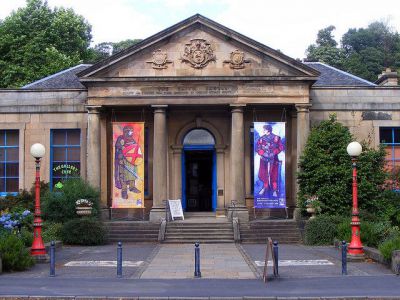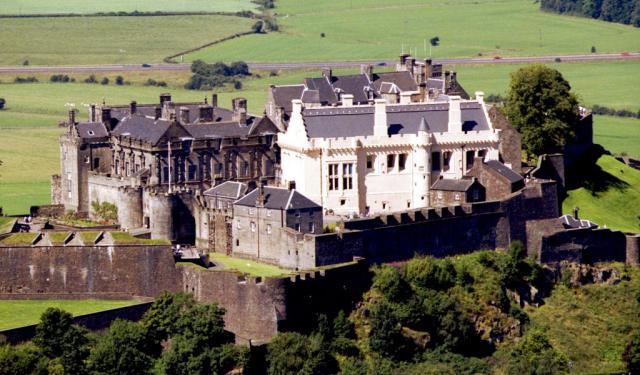The Stirling Smith Art Gallery and Museum, Stirling
The Stirling Smith Art Gallery and Museum, originally known as The Smith Institute, has been a significant cultural institution in Stirling since its establishment in 1874. Founded by a bequest from the artist Thomas Stuart Smith (1815–1869), it was built on land provided by the Burgh of Stirling as a public-private partnership. Originally intended as a gallery for contemporary art, a museum, and a reading room, it was designed to serve the people of Stirling, Dunblane, and Kinbuck.
Today, Stirling Smith continues to play a central role in the community. It functions not only as an art gallery and museum, showcasing both historical and contemporary works, but also as a cultural hub. The museum houses a diverse collection of historical artifacts and paintings related to Stirlingshire, while also providing space for exhibitions by modern artists. The venue supports over twenty community groups, with regular meetings held in its lecture theater. Visitors can also enjoy its café and explore its biodiversity garden.
Architecturally, the building features materials sourced locally, with most of the stone coming from Raploch Quarry and additional sandstone from Dunmore. Its grand frontage on Dumbarton Road is marked by a Doric portico, complete with four columns and intricate carvings. These include the Stirling seal, a wolf on one side and the Castle on the other, as well as a coat of arms that is believed to represent Thomas Stuart Smith, though it lacks formal heraldic recognition. The building also features two sculptural plinths and an empty niche on its exterior.
The longer frontage, facing Victoria Road and the Back Walk, is 218 feet (66 meters) in length and showcases two gabled sections with Venetian windows. The building’s pediments bear inscriptions that commemorate its founding in 1873, along with the names of the trustees and the architect, John Lessels of Edinburgh. The Stirling Smith has thus maintained its historic character while evolving into a vital center for culture and community engagement in the region.
Today, Stirling Smith continues to play a central role in the community. It functions not only as an art gallery and museum, showcasing both historical and contemporary works, but also as a cultural hub. The museum houses a diverse collection of historical artifacts and paintings related to Stirlingshire, while also providing space for exhibitions by modern artists. The venue supports over twenty community groups, with regular meetings held in its lecture theater. Visitors can also enjoy its café and explore its biodiversity garden.
Architecturally, the building features materials sourced locally, with most of the stone coming from Raploch Quarry and additional sandstone from Dunmore. Its grand frontage on Dumbarton Road is marked by a Doric portico, complete with four columns and intricate carvings. These include the Stirling seal, a wolf on one side and the Castle on the other, as well as a coat of arms that is believed to represent Thomas Stuart Smith, though it lacks formal heraldic recognition. The building also features two sculptural plinths and an empty niche on its exterior.
The longer frontage, facing Victoria Road and the Back Walk, is 218 feet (66 meters) in length and showcases two gabled sections with Venetian windows. The building’s pediments bear inscriptions that commemorate its founding in 1873, along with the names of the trustees and the architect, John Lessels of Edinburgh. The Stirling Smith has thus maintained its historic character while evolving into a vital center for culture and community engagement in the region.
Want to visit this sight? Check out these Self-Guided Walking Tours in Stirling. Alternatively, you can download the mobile app "GPSmyCity: Walks in 1K+ Cities" from Apple App Store or Google Play Store. The app turns your mobile device to a personal tour guide and it works offline, so no data plan is needed when traveling abroad.
The Stirling Smith Art Gallery and Museum on Map
Sight Name: The Stirling Smith Art Gallery and Museum
Sight Location: Stirling, Scotland (See walking tours in Stirling)
Sight Type: Museum/Gallery
Sight Location: Stirling, Scotland (See walking tours in Stirling)
Sight Type: Museum/Gallery
Walking Tours in Stirling, Scotland
Create Your Own Walk in Stirling
Creating your own self-guided walk in Stirling is easy and fun. Choose the city attractions that you want to see and a walk route map will be created just for you. You can even set your hotel as the start point of the walk.
Stirling Castle Walking Tour
Sitting atop Castle Hill in Stirling, Stirling Castle is one of the largest and most important castles in Scotland, both historically and architecturally. Before the union with England, the Castle was also one of the most used of the numerous Scottish royal residences, acting as both a palace and a fortress. Several Scottish kings and queens have been crowned at Stirling, including Mary, Queen of... view more
Tour Duration: 1 Hour(s)
Travel Distance: 0.8 Km or 0.5 Miles
Tour Duration: 1 Hour(s)
Travel Distance: 0.8 Km or 0.5 Miles
Stirling Introduction Walking Tour
On the River Forth in central Scotland, you'll find the picturesque city of Stirling. Its location at the lowest crossing point over the river made it a strategic spot to start a settlement. The town dates back to ancient Roman times, though much of the city is medieval and Victorian. It was a small market town that grew while becoming known as the "Gateway to the Highlands."
... view more
Tour Duration: 2 Hour(s)
Travel Distance: 2.3 Km or 1.4 Miles
... view more
Tour Duration: 2 Hour(s)
Travel Distance: 2.3 Km or 1.4 Miles





